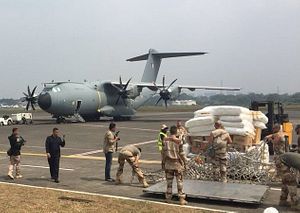This week, a French air force squadron paid its first visit to Vietnam in the contemporary bilateral relationship. The visit highlighted both the ongoing activity within the defense relationship of the two countries as well as France’s efforts to reinforce its security presence in Southeast Asia as well as the wider Indo-Pacific region.
As I have noted before in these pages, France is hardly a new player in the Asia-Pacific, and its influence has long been visible through various means be it the legacy of its colonial role, overseas territorial holdings, defense sales, and its involvement as one of several powers working for the preservation of the rules-based order. But with the new buzz around the “Indo-Pacific” in recent months, France’s forays into the region have been the subject of even greater attention, including in the defense realm.
This month, we have witnessed another aspect of this with respect to the focus of a regional air force deployment known as Mission PEGASE (Projection d’un dispositif aérien d’EnverGure en Asie du Sud-Est). The mission, which had been planned for months in advance, was designed such that following France’s participation in the air force exercise Pitch Black in Australia, a French Air Force squadron would conduct a series of stops on the way through to the United Arab Emirates and back to France which would include Indonesia, Malaysia, Vietnam, Singapore, and India.
The squadron itself was set to include three Rafale fighter aircraft, one A400M plane, one C-135 plane and one A310 plane, in addition to 100 personnel were dispatched for the mission, headed by General Patrick Charaix, commander of France’s Strategic Air Forces Command. And the stops were tied to other engagements and interactions meant to showcase France’s presence in the region, including ones initially planned as well as additional developments such as the diversion of the A400M plane to fly humanitarian assistance following the earthquakes in Indonesia’s Lombok.
Of these, the Vietnam leg, officially set from August 26 to August 29, was of particular note. It constitutes the first-ever visit by a French Air Force squadron to Vietnam in their contemporary ties. As France’s Charge d’Affairs to Vietnam Olivier Sigaud said at a press conference tied to the development, this was the first time since 1954 that French military aircraft appeared on Vietnamese skies and landed in a Vietnamese airport (1954 being the year Vietnam proclaimed its independence following the French defeat in the First Indochina War).
It also comes amid a key symbolic year for the relationship – it being both the 45th anniversary of the establishment of diplomatic ties and the fifth anniversary of the inking of the strategic partnership between the two sides. As I have noted before, this year has already seen a series of significant developments tied to these anniversaries, including on the defense side as part of wider engagements such as the trip of Nguyen Phu Trong, the general secretary of the Communist Party of Vietnam (CPV) in March (See: “Vietnam-France Ties in Focus with 45th Anniversary”). Mission PEGASE was just the latest of these interactions in this respect.
During the visit, Charaix, in his meetings with Vietnamese officials, reinforced the importance France attaches to the development of the defense aspect of the relationship. He framed Mission PEGASE as one of a series of steps to enhance the France-Vietnam defense relationship, with the engagement reinforcing France’s presence in the region and also showcasing some of its air force capabilities to partners such as Vietnam. And though he did not get into specifics, he referenced plans to follow up on the defense aspects of what was discussed by the two sides, including in terms of military training as well as areas of cooperation such as cybersecurity and UN peacekeeping.
How both sides look to follow through on these defense-related items through this year and beyond will be important to track for both the bilateral relationship as well as the wider region. Mission PEGASE was a reminder that in spite of the lingering challenges both sides face in making progress on some aspects of collaboration, there continues to be no shortage of activity in this regard.

































